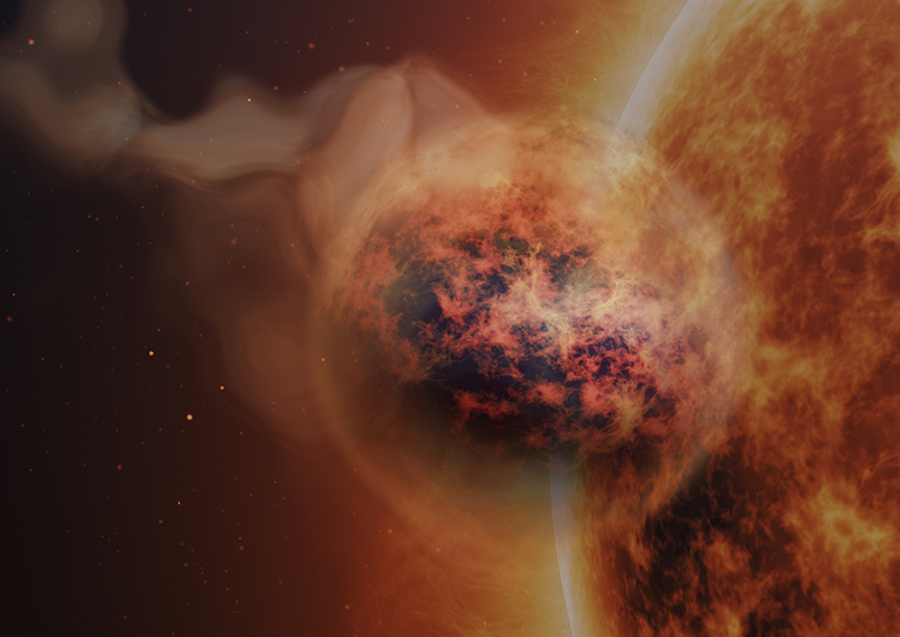
Michiel Min / European MIRI EXO GTO team / ESA / NASA / Klaas Verpoest (LUCA School of Arts, Belgium)
It’s a strange world not even the most imaginative science fiction authors ever came up with: a planet only twice as dense as Styrofoam, enveloped in high-altitude clouds of tiny sand particles. Yet it exists, a mere 200 light-years away in the constellation Virgo.
“I like to think of this enigmatic planet as one that might defy explanation for a while,” says Sara Seager (MIT), an exoplanet researcher who was not involved in the new research.
Known as WASP-107b, the low-density planet was discovered in 2017 by the South African station of the Wide Angle Search for Planets (WASP). WASP-107b orbits its parent star once every 5.7 days at a distance of a mere 0.06 astronomical unit (six times closer to its star than Mercury is to the Sun). Earlier observations revealed the planet to be almost as large as Jupiter but only about as massive as Neptune.
Using the Hubble Space Telescope, astronomers had already detected water vapor and helium in the planet’s extended atmosphere. They also found that the atmosphere was slowly leaking away into space, due to irradiation from the nearby parent star.
Now, new observations with the James Webb Space Telescope (JWST) reveal additional surprises.
A Strange Planet
A team led by Achrène Dyrek (University of Paris City), Michiel Min (SRON Netherlands Institute for Space Research), and Leen Decin (KU Leuven, Belgium) used JWST’s Mid-Infrared Instrument (MIRI) in January 2023 to obtain a detailed spectrum of WASP-107b during one of its frequent transits across the face of its star. The results are published in this week’s Nature.
Two surprising results had the scientists scratch their heads: MIRI revealed a much higher abundance of sulfur dioxide than predicted, while methane turned out to be completely absent.
According to Decin, the sulfur dioxide abundance could be explained by considering the extremely low density of the planet’s atmosphere. “Starlight penetrates to much deeper layers, setting off different kinds of photochemical reactions,” she says.
As for the nondetection of methane (which is abundant in the atmospheres of the giant planets in our own solar system), the researchers argue that this can only be explained by assuming that the atmospheric temperature rises very steeply with depth. While the planet’s outer layers are heated up to some 470°C (880°F), the temperature at a depth of 1,000 kilometers must reach values of up to 1,000°C — otherwise, methane molecules would surely have formed, explains Decin.
MIRI also detected evidence of “sand clouds” in the outermost atmospheric layers of WASP-107b. The tiny particles of solid silica partly obscure the spectroscopic features from further down. “This has never before been observed so clearly,” says Min.
Given the expected high wind velocities in the planet’s upper atmosphere, he speculates that a visiting spacecraft might well be sandblasted by the weird clouds.
Since microscopic sand particles are expected to “rain down” over time, some kind of atmospheric cycle must be active, remotely akin to the water cycle on Earth. The team suspects that the solid particles evaporate due to high temperatures further down. If even a shallow dip into the atmosphere brings significantly hotter temperatures (as indicated by the nondetection of methane), the silica will not have to rain too far down before it evaporates. Then vertical winds can easily bring the gaseous silica back into the upper atmosphere, where it again condenses into solid particles.
“What the authors say makes sense,” comments Seager. “Evidence for silicate particles high in the atmosphere indicate replenishing gas is brought up from deeper, hotter layers.”
Back in 2000, Seager and her colleagues already predicted the existence of clouds involving silicates, “but at that time we were not considering cycles,” she says. “Honestly, back then most astronomers did not think very many exoplanet atmospheres would ever be observed in so much detail.”
Outstanding Puzzles
According to Min, it’s still unclear why the temperature gradient in the interior of WASP-107b would be so steep, although it neatly explains the strongly inflated character of the planet. “It cannot be residual heat from the planet’s formation,” he says. “It’s too old for that. Maybe tidal effects from the parent star play a role, but no one knows for sure.”
Indeed, Yamila Miguel (Leiden Observatory, The Netherlands), who was not involved in the new research, notes that it’s “interesting to have more of these observations to better understand what drives this ‘inflation of the radius,’ which is currently unknown and debated.”
Another riddle, according to Miguel, concerns the composition of the very core of a puffed-up planet like WASP-107b. Does it consist mainly of rock, or ice? And could small amounts of hydrogen and helium be mixed in as well? “Since this is unknown for even the giant planets in our own solar system, it is definitely uncertain for exoplanets,” she says.
Meanwhile, Seager is enthusiastic about the new JWST results, and she expects much more to come. “This work is giving us a glimpse into just how diverse and complex exoplanet atmospheres actually are,” she says. “There’s so much going on in this field of research that it is very hard for anyone to keep up on all the new details.”
Govert Schilling
Artist’s impression credit:
